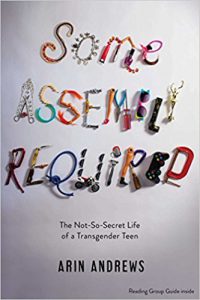Some Assembly Required: A Journal of My Son’s First Son, by Anne Lamott with Sam Lamott
Some Assembly Required: A Journal of My Son’s First Son
By Anne Lamott with Sam Lamott
Riverhead Books
Five Stars
Reviewed by Jessica Gribble
When you read Anne Lamott, you have to be prepared with a Kleenex box nearby and a pencil in hand. There are so many things to underline—feelings you’ve felt all your life but have never quite been able to express, moments of hilarity, expressions of fragility and joy. All of Lamott’s books express her true feelings, both good and bad, so poignantly that you need the Kleenex.
Some Assembly Required: A Journal of My Son’s First Son is Lamott’s edited journal from the first year of her grandson Jax’s life. Her son Sam was nineteen when his girlfriend Amy got pregnant and decided to keep the baby. Sam was determined to balance art school, his often fractious relationship with Amy, and fatherhood, so that Jax would have a dad around. He contributes frequent “interviews” to the book, so we get to know him as a young father, enraptured by the miracle of a growing son.
But this isn’t really a book about Sam, Amy, or even Jax. It’s about Anne Lamott’s perceptions of being a grandmother, her efforts to forge a new relationship with her son and his family, and her engagement with the rest of life. And that’s a very good thing. Lamott is often very funny, but she’s also often confused, unhappy, and struggling to restrain her frustration with other people. Just like the rest of us!
In the course of the book, Jax is born, Anne’s uncle Millard gets weaker and dies, and Anne takes a trip to India. Amy takes Jax to Chicago several times to visit her own family. Sam and Amy fight and make up. Birthdays are celebrated. And faith is always present, whether in Sam’s trip to a meditation center or Anne’s crucial relationship to Saint Andrew, her long-time church.
The true joy of reading this book is the way Lamott expresses her thoughts: always frankly and often with great poetry. One of the most impressive sections is her trip to India. I could practically feel the heat and see the landscape, but even better, I felt like I was discussing President Obama with cab drivers and meeting the street children begging for money. Lamott has a great talent for combining physical descriptions with descriptions of feelings: “We were on the Ganges at five in the morning, in a riverboat in the fog…. All four mornings we were in Varanasi, our boat was socked in with fog. This morning’s riverboat man said, “Too much the foggy!” which I think captures all of human life. It was a thick, white pea-soup fog—a vichyssoise fog—and apparently we were not going to see any of the sights I’d assumed we would see, and in fact had come here to see. But we saw something else: We saw how much better mystery shows up in the fog, how much wilder and truer each holy moment is than any fantasy.” Here she sums up the whole family: “Looking at Sam’s and Amy’s faces when they hold him [Jax], so madly in love, and watching Sam changing poopy diapers all the time nearly brings me to tears.” And her own wrestling with how to handle these relationships: “Besides, I knew beyond a shadow of doubt that if something was not my problem, I probably did not have the solution. There are no words for how much I hate, resent, and resist this.”
If you’ve ever found joy and mystery in traveling or in a baby, and if you sometimes hate, resent, and resist your inability to solve other people’s problems, this book is for you.
